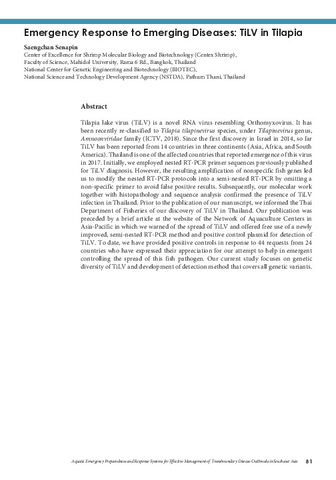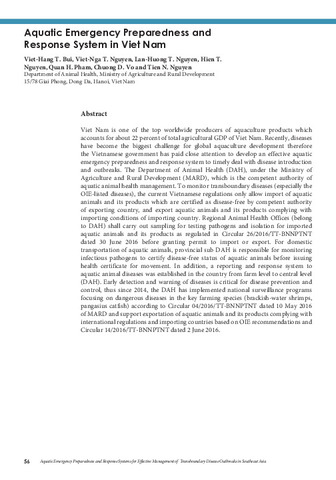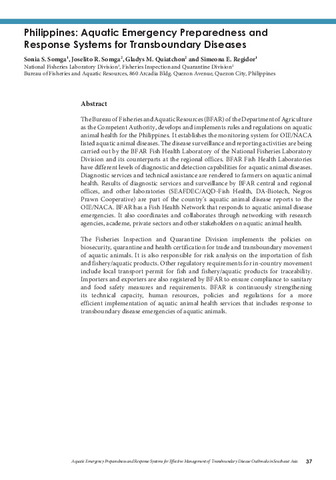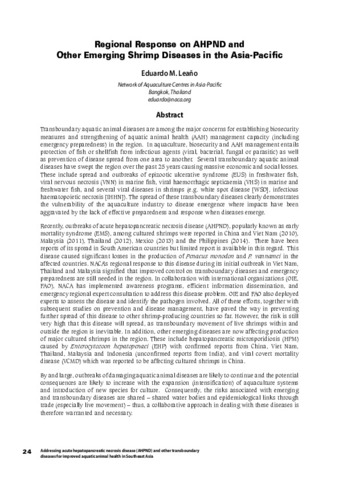Emergency response to emerging diseases: TiLV in tilapia
Share
ບົດຄັດຫຍໍ້
Tilapia lake virus (TiLV) is a novel RNA virus resembling Orthomyxovirus. It has been recently re-classified to Tilapia tilapinevirus species, under Tilapinevirus genus, Amnoonviridae family (ICTV, 2018). Since the first discovery in Israel in 2014, so far TiLV has been reported from 14 countries in three continents (Asia, Africa, and South America). Thailand is one of the affected countries that reported emergence of this virus in 2017. Initially, we employed nested RT-PCR primer sequences previously published for TiLV diagnosis. However, the resulting amplification of nonspecific fish genes led us to modify the nested RT-PCR protocols into a semi-nested RT-PCR by omitting a non-specific primer to avoid false positive results. Subsequently, our molecular work together with histopathology and sequence analysis confirmed the presence of TiLV infection in Thailand. Prior to the publication of our manuscript, we informed the Thai Department of Fisheries of our discovery of TiLV in Thailand. Our publication was preceded by a brief article at the website of the Network of Aquaculture Centers in Asia-Pacific in which we warned of the spread of TiLV and offered free use of a newly improved, semi-nested RT-PCR method and positive control plasmid for detection of TiLV. To date, we have provided positive controls in response to 44 requests from 24 countries who have expressed their appreciation for our attempt to help in emergent controlling the spread of this fish pathogen. Our current study focuses on genetic diversity of TiLV and development of detection method that covers all genetic variants.
Suggested Citation
Senapin, S. (2019). Emergency response to emerging diseases: TiLV in tilapia. In E. A. Tendencia, L. D. de la Peña, & J. M. V. de la Cruz (Eds.), Aquatic Emergency Preparedness and Response Systems for Effective Management of Transboundary Disease Outbreaks in Southeast Asia: Proceedings of Asean Regional Technical Consultation, 20-22 August 2018, Centara Grand Central Ladprao, Bangkok, Thailand (pp. 81-83). Tigbauan, Iloilo, Philippines: Aquaculture Department, Southeast Asian Fisheries Development Center.
ວິຊາ
disease control  ; Disease detection; disease resistance
; Disease detection; disease resistance  ; disease transmission
; disease transmission  ; epidemiology
; epidemiology  ; husbandry diseases
; husbandry diseases  ; aquaculture regulations
; aquaculture regulations  ; quarantine regulations
; quarantine regulations  ; fish culture
; fish culture  ; fish diseases
; fish diseases  ; freshwater aquaculture
; freshwater aquaculture  ; Freshwater fish; viral diseases
; Freshwater fish; viral diseases  ; infectious diseases
; infectious diseases  ; virology
; virology  ; viruses
; viruses  ; genetics
; genetics  ; emergencies
; emergencies  ; freshwater
; freshwater  ; Tilapinevirus; hepatopancreas
; Tilapinevirus; hepatopancreas  ; polymerase chain reaction
; polymerase chain reaction  ; fisheries
; fisheries  ; genes
; genes  ; fish
; fish  ; nucleic acids
; nucleic acids  ; lakes
; lakes  ; pathogens
; pathogens  ; protocols
; protocols  ; RNA
; RNA  ; aquaculture
; aquaculture  ; histopathology
; histopathology  ; detection
; detection  ; nucleotide sequence
; nucleotide sequence  ; plasmids
; plasmids  ; DNA
; DNA  ; inland waters
; inland waters  ; Genetic diversity; countries
; Genetic diversity; countries  ; Vibrio parahaemolyticus; Vibrio campbellii; Vibrio harveyi; Vibrio owensii; Amnoonviridae; Asia; Thailand
; Vibrio parahaemolyticus; Vibrio campbellii; Vibrio harveyi; Vibrio owensii; Amnoonviridae; Asia; Thailand
 ; Disease detection; disease resistance
; Disease detection; disease resistance  ; disease transmission
; disease transmission  ; epidemiology
; epidemiology  ; husbandry diseases
; husbandry diseases  ; aquaculture regulations
; aquaculture regulations  ; quarantine regulations
; quarantine regulations  ; fish culture
; fish culture  ; fish diseases
; fish diseases  ; freshwater aquaculture
; freshwater aquaculture  ; Freshwater fish; viral diseases
; Freshwater fish; viral diseases  ; infectious diseases
; infectious diseases  ; virology
; virology  ; viruses
; viruses  ; genetics
; genetics  ; emergencies
; emergencies  ; freshwater
; freshwater  ; Tilapinevirus; hepatopancreas
; Tilapinevirus; hepatopancreas  ; polymerase chain reaction
; polymerase chain reaction  ; fisheries
; fisheries  ; genes
; genes  ; fish
; fish  ; nucleic acids
; nucleic acids  ; lakes
; lakes  ; pathogens
; pathogens  ; protocols
; protocols  ; RNA
; RNA  ; aquaculture
; aquaculture  ; histopathology
; histopathology  ; detection
; detection  ; nucleotide sequence
; nucleotide sequence  ; plasmids
; plasmids  ; DNA
; DNA  ; inland waters
; inland waters  ; Genetic diversity; countries
; Genetic diversity; countries  ; Vibrio parahaemolyticus; Vibrio campbellii; Vibrio harveyi; Vibrio owensii; Amnoonviridae; Asia; Thailand
; Vibrio parahaemolyticus; Vibrio campbellii; Vibrio harveyi; Vibrio owensii; Amnoonviridae; Asia; Thailand
Related items
Showing items related by title, author, creator and subject.
-
Aquatic emergency preparedness and response system in Viet Nam
Bui, Viet-Hang T.; Nguyen, Viet-Nga T.; Nguyen, Lan-Huong T.; Nguyen, Hien T.; Pham, Quan H.; Vo, Chuong D.; Nguyen, Tien N. (Aquaculture Department, Southeast Asian Fisheries Development Center, 2019)Viet Nam is one of the top worldwide producers of aquaculture products which accounts for about 22 percent of total agricultural GDP of Viet Nam. Recently, diseases have become the biggest challenge for global aquaculture ... -
Philippines: Aquatic emergency preparedness and response systems for transboundary diseases
Somga, Sonia S.; Somga, Joselito R.; Quiatchon, Gladys M.; Regidor, Simeona E. (Aquaculture Department, Southeast Asian Fisheries Development Center, 2019)The Bureau of Fisheries and Aquatic Resources (BFAR) of the Department of Agriculture as the Competent Authority, develops and implements rules and regulations on aquatic animal health for the Philippines. It establishes ... -
Regional response on AHPND and other emerging shrimp diseases in the Asia-Pacific
Leaño, Eduardo M. (Aquaculture Department, Southeast Asian Fisheries Development Center, 2016)Transboundary aquatic animal diseases are among the major concerns for establishing biosecurity measures and strengthening of aquatic animal health (AAH) management capacity (including emergency preparedness) in the region. ...




